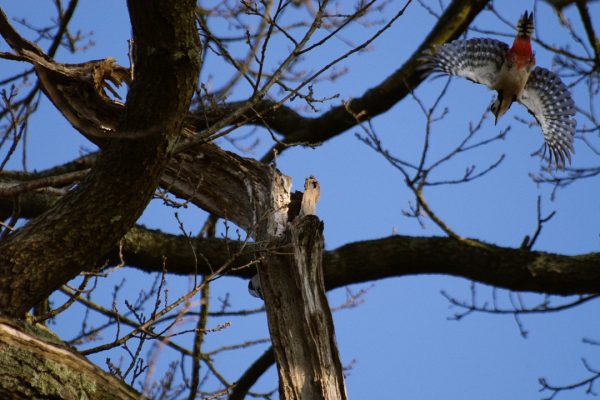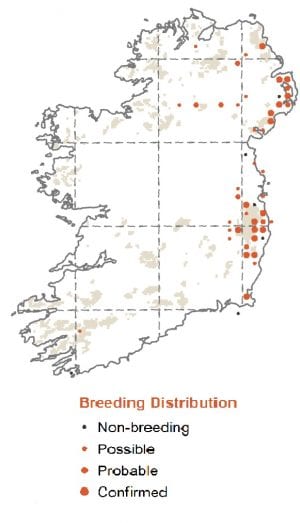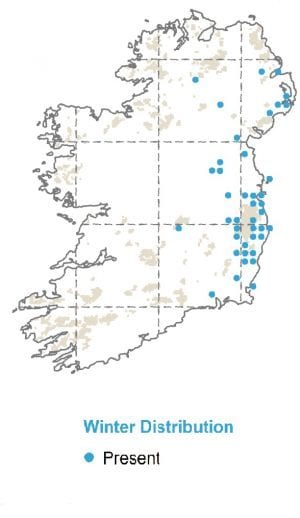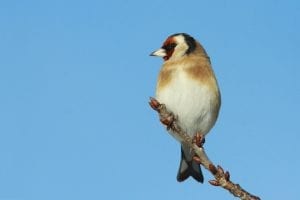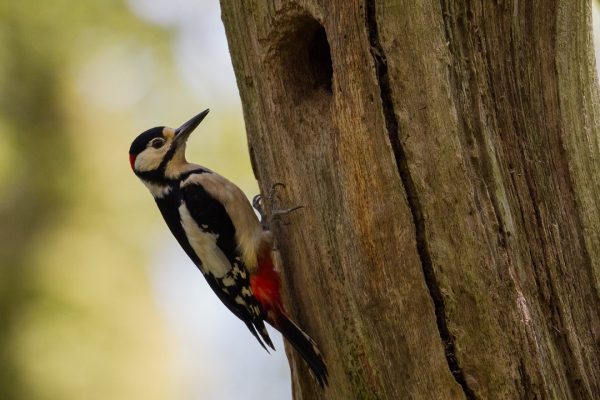
Great Spotted Woodpecker
| Irish Name: | Mórchnagaire breac |
| Scientific name: | Dendrocopus major |
| Bird Family: | Woodpeckers |
green
Conservation status
Conservation status
Status
Colonist to broadleaf forests in eastern Ireland since 2005. Since then, has greatly expanded its range to almost all other parts of the country. Map doesn't reflect their current range.
Identification
About the same size as Mistle Thrush. A distinctive black and white bird when seen well. The face, throat and underparts are white, while the back, rump and tail are black. Also has a large white patch at the base of the wings, while the vent is pale red. In flight, the wings are mainly black, with obvious rows of spotting on the primaries and secondaries. Adult male Great Spotted Woodpeckers are identifiable by a small red patch on the back of the head. Adult females have a black nape and crown.
Voice
The most frequently heard call is a loud "kick", when agitated given in a continuous series. Does not sing, but has distinctive drumming display from early spring onwards. Drums last between 1 and 2 seconds.
Diet
Feeds on insects found in wood, as well as pine cones in autumn. During the breeding season, may also take eggs and chicks of other birds. Will visit garden bird tables in suburban areas.
Breeding
A scarce but increasing breeder in Ireland, usually in oak woodlands with some coniferous woods nearby. A common species in Britain and Continental Europe and frequently visits bird feeders in gardens. Breeds in nesting cavities which it excavates in decaying wood.
Wintering
Great Spotted Woodpeckers remain on their territory during the winter. Young birds move to new territories in autumn
Monitored by
Countryside Bird Survey, Great Spotted Woodpecker Survey and BirdTrack.
Blog posts about this bird
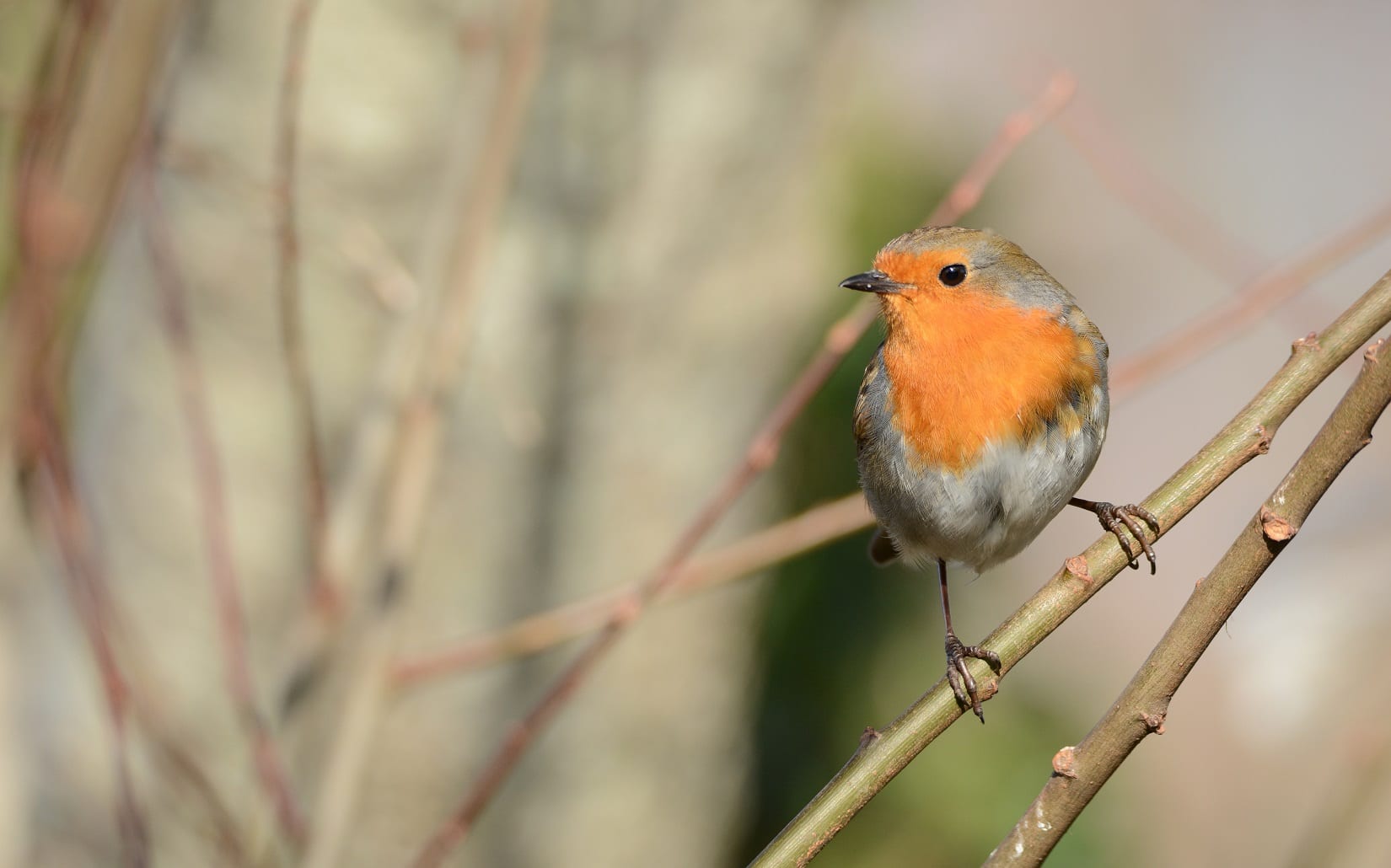
BirdWatch Ireland Calls for Public Participation in Critical Bird Survey Starting November 25th
BirdWatch Ireland is calling on people across the country to help monitor the health of the country’s bird populations by counting the birds visiting their garden over the winter.
Ireland’s longest-running and most popular citizen science survey, the Irish Garden Bird Survey, will commence on Monday, November 25th and run until the end of February. Taking part is free and simple, yet impactful, as all participants contribute to a crucial body of data that will help to inform monitoring and research into bird populations and environmental change.
Last year’s survey, which saw over 1,600 households across the country participating, revealed the Robin as Ireland’s top garden bird once again, present in 96% of gardens. Blackbird and Blue Tit followed in second and third place, occurring in 94% and 91% of gardens respectively. However, all three species appeared in fewer gardens than at any point in the last thirty years due to the mild winter weather conditions, which reduced birds’ need for garden feeders.
Of the top 30 species seen in Irish gardens last winter, 25 occurred in a lower percentage of gardens than the previous winter.






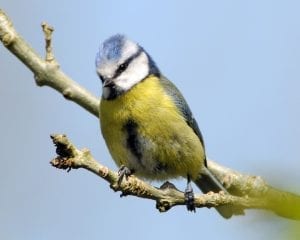
Blue Tit. Photo: Michael Finn.
“We often get emails from people early in the winter wondering where their garden birds are, but last winter people all over the country were commenting on how quiet their gardens were,” said Brian Burke, coordinator of the Irish Garden Bird Survey. “This week we’re seeing very cold conditions across the country, and that’s definitely driving more birds into gardens at the moment, so it’ll be interesting to see what the coming weeks bring. The more people who do the survey, the more we can learn about these sorts of links between climate, birds and our environment.”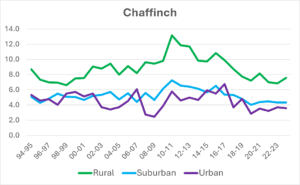
Average Chaffinch numbers per garden show that they occur in greater flock sizes in rural gardens than urban or suburban ones.
Other species including Chaffinch, Coal Tit and Jackdaw were at their lowest occurrence in 30 years, while Song Thrush and Pied Wagtail showed a huge drop of 12% since the previous winter. One species, the Siskin, bucked this trend, occurring in 41% of gardens compared to 26% the previous year. This is largely due to their reliance on alder, birch, spruce and pine tree seeds as a food source. Considering the cyclical nature of seed supply, such peaks in Siskin numbers are expected every three years or so. They tend to occur in relatively few gardens in December, increasing in January, and becoming much more common throughout February. Similar mid-winter increases were seen with Redpoll and Long-tailed Tit, amongst other species.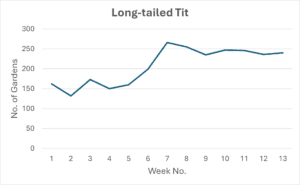
Long-tailed Tit occurrence in gardens increased greatly after the first week of January (Week 6) and remained high until the end of February.
While it was anticipated that Greenfinch would experience declines due to the impact of the deadly Trichomoniasis condition on the species, it was one of very few species with a stable trend and virtually no change from the previous winter. Greenfinch have occurred in 47-48% of gardens in each of the last three winters, which may indicate that their rapid declines have stabilised. The species is currently on the Amber list as a species of medium-level conservation concern. As usual, there are clear differences in the birds visiting gardens across the country. Notable differences in Ulster include Blackbird being the most widespread species, Goldfinch not featuring in the top 10 (12th), and it being the only province with either Jackdaw or Song Thrush in the top 10. Out west in Connaught, Coal Tit and Wren came in 9th and Starling only in 13th. Leinster was once again the only region to feature Woodpigeon in the top 10. The top 10 in Munster was very similar to the national rankings, though notably, the Rook was the 11th most common species there, much higher than elsewhere. As a conservation charity with a small team, BirdWatch Ireland is reliant on members of the public to help gather vital data about Ireland’s many bird species. In addition to contributing valuable information, participants often enhance their bird identification skills and gain insights into the journeys these birds undertake. Indeed, some of last year’s participants reported ringed birds that visited their gardens including a Goldfinch discovered in Tipperary that was originally ringed in Maine-et-Loire in France, and a Redwing found in Carlow that was ringed at Sandwich Bay Bird Observatory in Kent, England.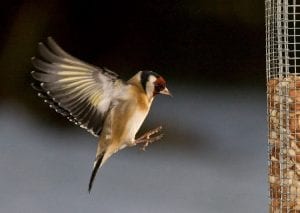
Goldfinch. Photo: Kevin Murphy.
Taking part in the Irish Garden Bird Survey is a win-win for science and for individual participants and this year, BirdWatch Ireland hopes to encourage even more people to take part. All you need to get involved is a little bit of time each week to watch your garden birds, access to a garden or any outdoor space such as a community garden or school grounds, and a sense of curiosity. The Irish Garden Bird Survey is once again sponsored by Ballymaloe, whose support in recent years has helped ensure the survey has gone from strength to strength, improving monitoring at national level and allowing for greater focus on conservation issues facing individual species. Commenting on their ongoing support for the survey, a Ballymaloe spokesperson said: "United in our commitment to the environment and inspired by the legacy of our forefather, Ivan Allen, Ballymaloe businesses as a group proudly sponsor BirdWatch Ireland's annual Irish Garden Bird Survey. Mr Ivan Allen, the husband of Myrtle Allen and a devoted lover of birdlife, cherished the natural habitat around Ballymaloe House, and practised sustainable farming way ahead of his time. In his memory, our collective support for the Irish Bird Survey reflects our ongoing celebration of Mr Allen's passion for birdlife and commitment to conservation. Together Ballymaloe House Hotel, the Ballymaloe Cookery School and Ballymaloe Foods are honoured to contribute towards supporting the preservation of Irish birdlife via BirdWatch Ireland's important national Irish Garden Bird Survey initiative in his name. We encourage as many households as possible to get involved, every entry helps BirdWatch Ireland protect birdlife on the island of Ireland." To learn more about the survey and to get involved, see here: https://birdwatchireland.ie/our-work/surveys-research/research-surveys/irish-garden-bird-survey/.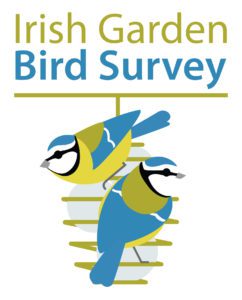
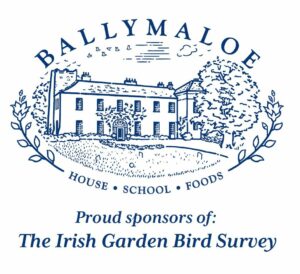
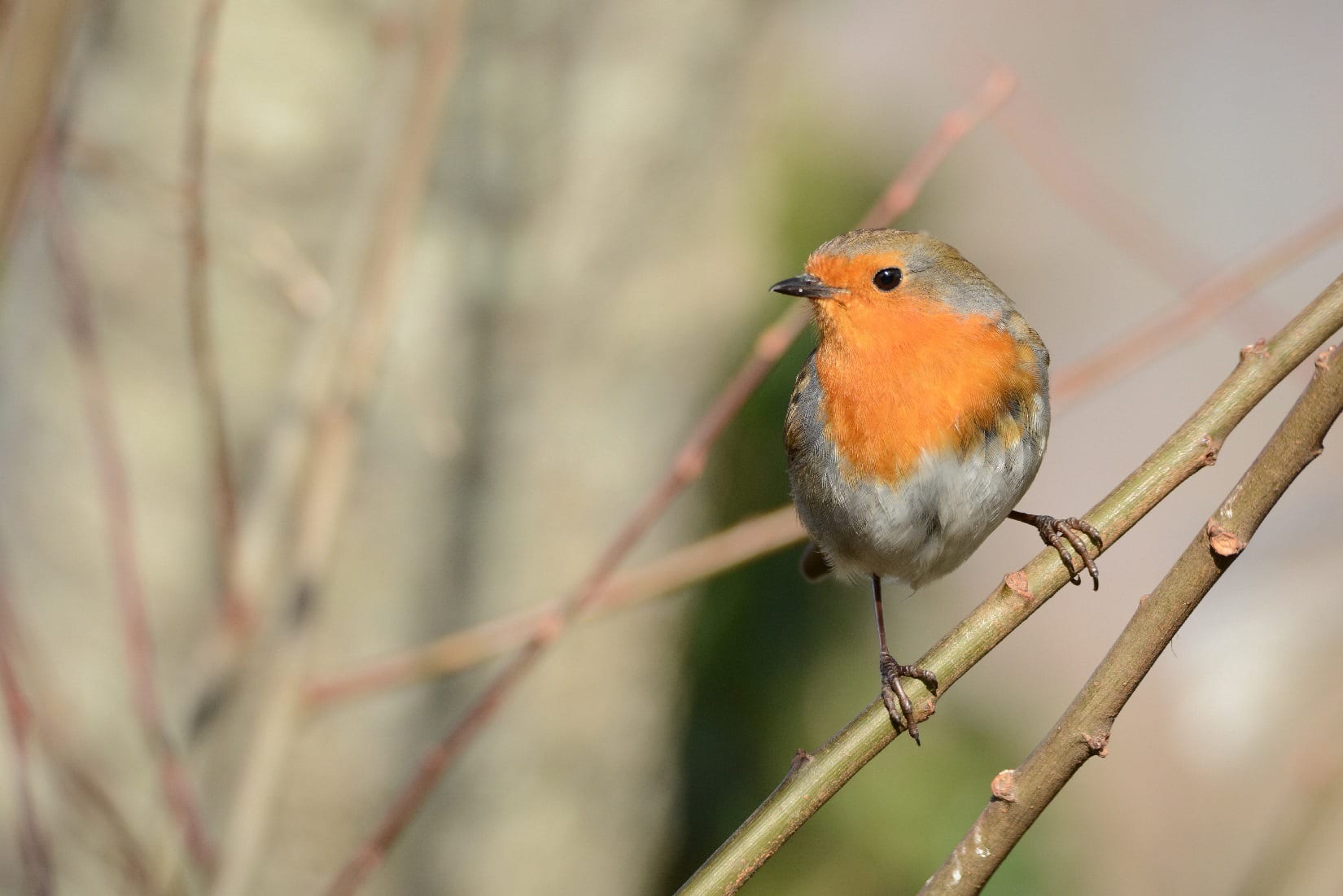
35th Irish Garden Bird Survey is ready to take flight
Birds inject a huge amount of joy into our lives, creating the soundtrack to spring mornings and brightening up our gardens on otherwise drab winter days.
As we approach what is widely considered the “season of giving”, one surefire way to give back to the birds for all that they do for us is to participate in this year’s Irish Garden Bird Survey – the most popular and longest-running citizen science survey in Ireland.

 Last year, the Robin came out on top again in Irish gardens having been seen in 99% of gardens, though were pushed to second place by the Blackbird in counties Wicklow, Offaly, Kildare and Antrim. The mild weather over the majority of last winter meant that many species were similarly widespread as in previous winters. In addition to Robin and Blackbird, Blue Tits and Magpies both occurred in over 90% of Irish gardens, while Great Tit, Chaffinch, House Sparrow and Goldfinch were in over 80% of gardens. For House Sparrow, it was their second-best year on record, likely due to a bumper breeding season. The species is on the ‘Amber list’ of Birds of Conservation Concern, so this positive trend is to be welcomed.
Though the winter weather was mostly mild, there were a few short spells of snow which drove birds into gardens in higher numbers. The first species affected by this are often the birds in the thrush family, including our resident Song Thrush and Mistle Thrush, migrant Redwing from Iceland and Fieldfare from Scandinavia.
“Despite the temperatures being mild overall, we seem to be getting more storms and multiple short snowy spells in recent years, and these can be enough to deplete birds’ fat reserves and put them under real pressure. Song Thrush occurred in an extra 12% of gardens last year owing to the snowy weather” said Burke. “So, these are the times when your garden birds really need you to provide food and water, and if you can put these out a few days before any snow hits then you’re giving the birds a chance to realise it’s there, so they know exactly where to go when the ground freezes over.”
Last year, the Robin came out on top again in Irish gardens having been seen in 99% of gardens, though were pushed to second place by the Blackbird in counties Wicklow, Offaly, Kildare and Antrim. The mild weather over the majority of last winter meant that many species were similarly widespread as in previous winters. In addition to Robin and Blackbird, Blue Tits and Magpies both occurred in over 90% of Irish gardens, while Great Tit, Chaffinch, House Sparrow and Goldfinch were in over 80% of gardens. For House Sparrow, it was their second-best year on record, likely due to a bumper breeding season. The species is on the ‘Amber list’ of Birds of Conservation Concern, so this positive trend is to be welcomed.
Though the winter weather was mostly mild, there were a few short spells of snow which drove birds into gardens in higher numbers. The first species affected by this are often the birds in the thrush family, including our resident Song Thrush and Mistle Thrush, migrant Redwing from Iceland and Fieldfare from Scandinavia.
“Despite the temperatures being mild overall, we seem to be getting more storms and multiple short snowy spells in recent years, and these can be enough to deplete birds’ fat reserves and put them under real pressure. Song Thrush occurred in an extra 12% of gardens last year owing to the snowy weather” said Burke. “So, these are the times when your garden birds really need you to provide food and water, and if you can put these out a few days before any snow hits then you’re giving the birds a chance to realise it’s there, so they know exactly where to go when the ground freezes over.”
 Some very rare species were spotted in small numbers in Ireland last winter such as Bramblings, Lesser Whitethroats, Black Redstarts, Snow Buntings and Ring-necked Parakeets.
Some very rare species were spotted in small numbers in Ireland last winter such as Bramblings, Lesser Whitethroats, Black Redstarts, Snow Buntings and Ring-necked Parakeets.
35 years of the Irish Garden Bird Survey
Now in its 35th year, the Irish Garden Bird Survey grants people across the country the opportunity to serve as our eyes on the ground by observing and recording birds in their gardens, on school grounds, on their balconies, or within any other space they enjoy daily. All of this information gives us insight into how different species are faring and, in turn, helps us to identify current threats and future conservation priorities.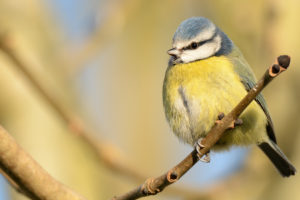
Blue Tit. Photo: Brian Burke.
The Irish Garden Bird Survey is perhaps our most simple and inclusive survey, one in which people of all ages, backgrounds and experience levels can play their part. In fact, it is so simple that, whether or not you have heard of the Irish Garden Bird Survey, it is likely that you are already doing the work. “The Irish Garden Bird Survey is something you can do with a cup of tea looking out the window. You can do it as you're washing the dishes or filling the kettle. People are always watching their garden birds during the winter anyway. That’s when the garden bird numbers peak. The birds are driven to gardens to look for food and people might be inside a lot more because the weather isn’t as good,” says Coordinator of the Irish Garden Bird Survey, Brian Burke. “As we always tell people, you are probably doing this anyway. We just are asking you to go that extra step by writing down and sending us what you see.” While participating in the Irish Garden Bird Survey does not take a lot of time or effort, the impact of the data collected by participants over the past 35 years has been huge. Thanks to them, we now know that Robins, Blackbirds and Blue Tits are the most common garden bird species in Ireland. We know that species such as Great Spotted Woodpecker are on the rise. We know that the breeding Greenfinch numbers have plummeted by 48 per cent in recent years, a loss that can be almost entirely linked to trichomoniasis – a fatal disease caused by a microscopic parasite which predominantly affects finches.2022/ 2023 Irish Garden Bird Survey Results
While there is some consistency in terms of what species are most common, cold winter weather, autumn food supplies, and the success of the summer breeding season just gone all play a part in what birds arrive in Irish gardens at this time of year.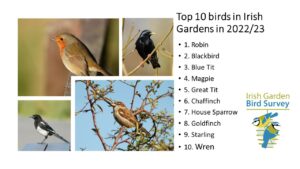 Last year, the Robin came out on top again in Irish gardens having been seen in 99% of gardens, though were pushed to second place by the Blackbird in counties Wicklow, Offaly, Kildare and Antrim. The mild weather over the majority of last winter meant that many species were similarly widespread as in previous winters. In addition to Robin and Blackbird, Blue Tits and Magpies both occurred in over 90% of Irish gardens, while Great Tit, Chaffinch, House Sparrow and Goldfinch were in over 80% of gardens. For House Sparrow, it was their second-best year on record, likely due to a bumper breeding season. The species is on the ‘Amber list’ of Birds of Conservation Concern, so this positive trend is to be welcomed.
Though the winter weather was mostly mild, there were a few short spells of snow which drove birds into gardens in higher numbers. The first species affected by this are often the birds in the thrush family, including our resident Song Thrush and Mistle Thrush, migrant Redwing from Iceland and Fieldfare from Scandinavia.
“Despite the temperatures being mild overall, we seem to be getting more storms and multiple short snowy spells in recent years, and these can be enough to deplete birds’ fat reserves and put them under real pressure. Song Thrush occurred in an extra 12% of gardens last year owing to the snowy weather” said Burke. “So, these are the times when your garden birds really need you to provide food and water, and if you can put these out a few days before any snow hits then you’re giving the birds a chance to realise it’s there, so they know exactly where to go when the ground freezes over.”
Last year, the Robin came out on top again in Irish gardens having been seen in 99% of gardens, though were pushed to second place by the Blackbird in counties Wicklow, Offaly, Kildare and Antrim. The mild weather over the majority of last winter meant that many species were similarly widespread as in previous winters. In addition to Robin and Blackbird, Blue Tits and Magpies both occurred in over 90% of Irish gardens, while Great Tit, Chaffinch, House Sparrow and Goldfinch were in over 80% of gardens. For House Sparrow, it was their second-best year on record, likely due to a bumper breeding season. The species is on the ‘Amber list’ of Birds of Conservation Concern, so this positive trend is to be welcomed.
Though the winter weather was mostly mild, there were a few short spells of snow which drove birds into gardens in higher numbers. The first species affected by this are often the birds in the thrush family, including our resident Song Thrush and Mistle Thrush, migrant Redwing from Iceland and Fieldfare from Scandinavia.
“Despite the temperatures being mild overall, we seem to be getting more storms and multiple short snowy spells in recent years, and these can be enough to deplete birds’ fat reserves and put them under real pressure. Song Thrush occurred in an extra 12% of gardens last year owing to the snowy weather” said Burke. “So, these are the times when your garden birds really need you to provide food and water, and if you can put these out a few days before any snow hits then you’re giving the birds a chance to realise it’s there, so they know exactly where to go when the ground freezes over.”
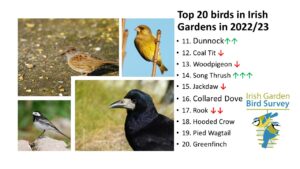 Some very rare species were spotted in small numbers in Ireland last winter such as Bramblings, Lesser Whitethroats, Black Redstarts, Snow Buntings and Ring-necked Parakeets.
Some very rare species were spotted in small numbers in Ireland last winter such as Bramblings, Lesser Whitethroats, Black Redstarts, Snow Buntings and Ring-necked Parakeets.
Getting involved in the survey
The value of an individual’s participation in the Irish Garden Bird Survey is not dependent on their bird knowledge, location or garden size but rather, their willingness to get involved every winter. “The value of the survey is when people do it year after year because we can monitor the change then. It doesn’t matter if you have three species in your garden and someone else has 30, we want to find out how those three species fare over time. That is the real crux of the survey,” explains Brian. “We want to hear from people with and without feeders. We want results from every type of garden in the country so that the survey results are representative of the whole country.”Goldfinch. Photo: Dick Coombes.
The Irish Garden Bird Survey is once again sponsored by Ballymaloe, whose support in recent years has helped ensure the survey has gone from strength to strength, improving monitoring at national level and allowing for greater focus on conservation issues facing individual species. “United in our commitment to the environment and inspired by the legacy of our forefather, Ivan Allen, Ballymaloe businesses as a group proudly sponsor BirdWatch Ireland's annual Irish Garden Bird Survey. Mr Ivan Allen, the husband of Myrtle Allen and a devoted lover of birdlife, cherished the natural habitat around Ballymaloe House, and practised sustainable farming way ahead of his time. In his memory, our collective support for the Irish Bird Survey reflects our ongoing celebration of Mr Allen's passion for birdlife and commitment to conservation,” said Marketing and Digital Manager at Ballymaloe House Hotel, Helen Cuddigan. “Together Ballymaloe House Hotel, the Ballymaloe Cookery School and Ballymaloe Foods are honoured to contribute towards supporting the preservation of Irish birdlife via BirdWatch Ireland's important national Irish Garden Bird Survey initiative in his name. We encourage as many households as possible to get involved, every entry helps BirdWatch Ireland protect birdlife on the island of Ireland.” Participating in the Irish Garden Bird Survey each winter is a simple and effective way of contributing to a crucial body of data that will help to guide conservation. Through taking part, you are also sure to reap many rewards as the survey offers an opportunity to increase your bird knowledge, take a daily pause and perhaps, create memorable moments with friends and family. The Irish Garden Bird Survey will kick off on Monday, November 27th. For instructions on how to take part, see the Irish Garden Bird Survey page on our website here.
